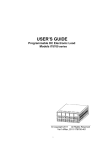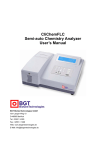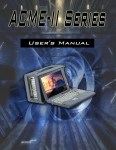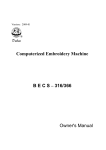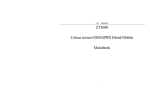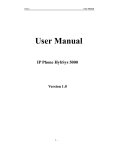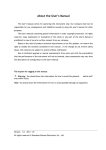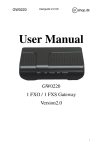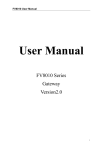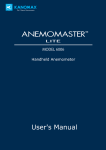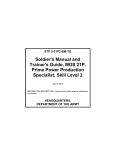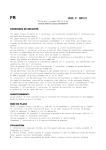Download eddysun (xiamen) electronic co., ltd.
Transcript
EDDYSUN EEC-30S USER MANUAL EDDYSUN (XIAMEN) ELECTRONIC CO., LTD. June, 2014 User Manual of EEC-30S CATALOG 1.0 GENERAL DESCRIPTION ................................................................................................................... - 1 1.1 CHARACTERS OF EQUIPMENT...................................................................................................................... - 1 1.2 STRUCTURE OF EQUIPMENT ....................................................................................................................... - 2 1.3 SAFETY AND ANNOUNCEMENTS ................................................................................................................... - 3 - 1.3.1 Safety terminology ........................................................................................................................ - 3 1.3.2 Matters need to pay attention to ................................................................................................ - 3 2.0 INSTALLATION AND CONNECTION OF EQUIPMENT............................................................... - 5 2.1 INSTALLATION OF HARDWARE ..................................................................................................................... - 5 - 2.1.1 Unpacking ...................................................................................................................................... - 5 2.1.2 Component of equipment ............................................................................................................ - 5 2.1.3 Mainframe ...................................................................................................................................... - 5 2.1.4 Connection of equipment............................................................................................................. - 7 2.2 INSTALLATION OF SOFTWARE ...................................................................................................................... - 7 3.0 OPERATION ..........................................................................................................................................- 11 3.1 INTRODUCTION OF FUNCTIONAL KEY ........................................................................................................ - 11 3.2 BRIEF INTRODUCTION OF SCREEN WINDOWS............................................................................................ - 12 3.3 FILE......................................................................................................................................................... - 13 - 3.3.1 Save DAT file ............................................................................................................................... - 14 3.3.2 Open DAT file .............................................................................................................................. - 14 3.3.3 Save PAR file ............................................................................................................................... - 14 3.3.4 Open PAR file .............................................................................................................................. - 14 3.3.5 Copy image to clipboard / Save image as JPG file ................................................................ - 15 3.4 SETTING .................................................................................................................................................. - 15 - 3.4.1 Balance position .......................................................................................................................... - 15 3.4.2 Option ........................................................................................................................................... - 15 3.4.3 Properties ..................................................................................................................................... - 16 3.4.4 Probe calibration ......................................................................................................................... - 17 3.4.5 Measure ........................................................................................................................................ - 19 3.4.6 Impedance plane to center ....................................................................................................... - 19 3.4.7 Impedance plane 180Deg rotation ........................................................................................... - 19 3.4.8 Recover parameter ..................................................................................................................... - 19 3.5 VIEW ....................................................................................................................................................... - 19 3.6 ALARM ..................................................................................................................................................... - 20 - 3.6.1 Alarm mode ................................................................................................................................. - 21 3.6.2 Set alarm area ............................................................................................................................. - 22 3.7 SET PARAMETER ....................................................................................................................................... - 22 - 3.7.1 Gain ............................................................................................................................................... - 23 3.7.2 Phase............................................................................................................................................. - 24 3.7.3 Signal ............................................................................................................................................ - 24 3.7.4 Frequency ..................................................................................................................................... - 25 - i User Manual of EEC-30S 3.7.5 High pass ...................................................................................................................................... - 26 3.7.6 Low pass ....................................................................................................................................... - 26 3.7.7 Filt .................................................................................................................................................. - 26 3.7.8 Chart speed .................................................................................................................................. - 27 3.7.9 Disp mode .................................................................................................................................... - 27 3.7.10 Disp factor .................................................................................................................................. - 27 3.7.11 Ratio Y/X .................................................................................................................................... - 27 3.7.12 Clock select ................................................................................................................................ - 28 3.7.13 Start delay .................................................................................................................................. - 28 3.7.14 End delay .................................................................................................................................... - 28 3.7.15 Mark delay .................................................................................................................................. - 29 3.7.16 Mark duration ............................................................................................................................ - 29 3.7.17 Pulse/m ....................................................................................................................................... - 29 3.7.18 Format ........................................................................................................................................ - 29 4.0 ON-SITE INSPECTION EXAMPLES ............................................................................................... - 30 4.1 OFF-LINE INSPECTION SYSTEM .................................................................................................................. - 30 - 4.1.1 Connection of equipment........................................................................................................... - 30 4.1.2 Parameter setting........................................................................................................................ - 32 4.2 ON-LINE INSPECTION SYSTEM ................................................................................................................... - 36 - 4.2.1 Connection of equipment........................................................................................................... - 36 4.2.2 Parameter setting........................................................................................................................ - 37 5.0 COMMON MALFUNCTIONS ............................................................................................................. - 41 6.0 MAINTENANCE ................................................................................................................................... - 42 6.1 MAINTENANCE.......................................................................................................................................... - 42 6.2 STORAGE ................................................................................................................................................. - 43 7.0 APPENDIX ............................................................................................................................................ - 44 APPENDIX 1 FUNDAMENTAL ............................................................................................................................. - 44 APPENDIX 2 EDDY CURRENT PROBE ................................................................................................................. - 47 APPENDIX 3 MAKE STANDARD SAMPLE AND COMPARATIVE SAMPLE .................................................................... - 50 APPENDIX 4 AUXILIARY DEVICE OF EC TEST AND THE USES .............................................................................. - 54 - ii User Manual of EEC-30S 1.0 GENERAL DESCRIPTION EEC-30S eddy current (EC) instrument is a new generation of eddy current instrument, advanced digital electronic technique, and micro-technique. It can test the internal wall and external wall defects of ferromagnetic and non-ferromagnetic metal tube. Designed with 2 independent testing channels, the equipment can collect both absolute eddy-current signals and differential eddy current signals. The equipment can be used as two eddy current testers (each tester has one-channel). The frequency range is from 64Hz to 5MHz, enabling the equipment suitable to be used in department of nuclear energy, electric power, petrochemical, aviation to test defects and measure wall thickness of tubes and metal components of in-service copper, Ti, Zirconium etc; and to test, analyze, evaluate varieties of ferromagnetic tubes. 1.1 Characters Of Equipment ● ● ● ● ● ● ● ● ● ● ● ● ● ● ● ● ● ● ● ● Frequency range: 64 Hz~5 MHz 2 independent channels Real-time memorize multi-track eddy current signal Range of gain: 0~96dB with step of 0.5dB Phase rotation: 0~359° with step of 1° Fast digital / analogue electric balance Single, two impedance plan and time-base scan display Man-machine conversation Measure extent and phase of signal automatically, replay eddy current signal Digital filtering Configuration analysis function Can match with absolute, differential probes, such as feed-through probe, pencil probe etc. Non-equal amplitude phase/amplitude alarm 8 output ports of hardware alarm Store testing program and testing data Automatically display curve of phase/defect depth Rectangular coordinates and polar coordinates can be selected Display cross-section diagram of in-service tube and number of tested tubes at the same screen, and eddy current testing signal Graded display cross-section diagram of tubes, and to form the general picture of eddy current testing of in-service tube Graded stat. Testing result for further analysis -1- User Manual of EEC-30S ● Automatically display the calendar and time ● Can be equipped with data analysis system 1.2 Structure Of Equipment The structure diagram of EEC-30S is showed as Figure 1-1: 3 1 4 5 6 2 7 3 4 5 8 6 Figure 1-1 Structural diagram 1: Waveform generator (multi-frequency) 2: Tested probe 3: Pre-amplification phase sensitive detection 4: Balancing filter 5: Digital phase rotation 6: Adjustable gain amplification 8: Computer EEC-30S can excite testing coil simultaneity using 2 different frequencies. After excited by different frequencies, different eddy-current testing signal will be collected, and then by plus-minus of vectors and other process, to collect desired signal. EEC-30S tester is controlled by computer, and produce frequency by quartz crystal, and produce waveform generator (whose frequency doubling can be adjustable) through frequency doubler, and then to obtain sine wave which is required for exciting. Select two different frequencies according to requirements of test, after amplified by power amplifier, send them at the same time to the exciting coil of tested probe. Different eddy current -2- User Manual of EEC-30S signals can be obtained through different testing coils, and then enter into different channels. And through pre-amplification, phase sensitive detection, balancing filter, phase rotation and adjustable gain amplifier. The computer will control and calculate the equipment and display the diagram. Software is the key section of the equipment. The main testing software contains: “1 impedance plane”, “2 impedance plane” and “tube sheet display”. All these menus can be transferred conveniently. 1.3 Safety and Announcements 1.3.1 Safety terminology The following terminologies may appear in this operating guide: ▲ Warning: Warning statement, point out conditions and actions that may hurt people. ▲ Notice: Notice statement, point out conditions and actions that may damage the equipment and other assets. 1.3.2 Matters need to pay attention to Please use dependable external power with reliable quality to avoid electric shock and fire. The voltage of external power connected is 220V, please make sure the equipment is set earthed. Please don’t randomly open the outside surface of the equipment, and avoid any metal components fall into the equipment. Extreme temperature will affect the normal operation of the equipment. Please don't let the equipment work under extreme temperature if possible. To avoid explosion caused by short circuit, please don't put the equipment in a wet and explosive environment. Pay attention to the rated value of peripheral devices connected. To avoid causing fire or electric shock, please take the safety precautions while connecting equipment and its peripheral devices. Please ask for details or read this operating guide carefully before -3- User Manual of EEC-30S installing and connecting. To avoid touching bare circuit, please don’t operate the equipment without cover board. Please shut off the power when there’re malfunctions. And then ask for the engineer or send the equipment to the manufacturer. Heavy vibration and shock to the equipment is forbidden. And to avoid sliding, please place the equipment in a firm position. To avoid distortion and damage to equipment, please don’t place heavy things on it. Please keep the surface of equipment clean and dry. Please avoid interference from external strong magnetic field. -4- User Manual of EEC-30S 2.0 INSTALLATION AND CONNECTION OF EQUIPMENT 2.1 Installation of Hardware The equipment is designed with full-digital, and built-in computer, so control buttons are not required. All functions and operations are controlled by software. This makes it easy to install and debug. 2.1.1 Unpacking Be sure the contents of your shipment match all items listed on the packing list, and the package is in good condition. Place the equipment on the suitable place. 2.1.2 Component of equipment The equipment mainly consists of mainframe and display. Outer components, such as mouse, printer, CD-writer and CD-ROM can be selected as per user's requirements. Equipment has been set up with software system before it is shipped. Other softwares are optional as well. 2.1.3 Mainframe The mainframe consists of computer, EC circuit and correlative control modules. 1. Front panel of mainframe The front panel of mainframe and introduction is shown as Figure 2-1: -5- User Manual of EEC-30S EEC-30S Eddy Current Tester Type Name Power Led Hard Disk Led Power Switch Reset Switch Figure 2-1 Front panel of mainframe 2. Back panel of mainframe The front panel of mainframe and introduction is shown as Figure 2-2: Figure 2-2 Back panel of mainframe A: Input socket of power supply (AC 220V) Notice: The input rated voltage is AC 220V. To avoid suddenness, the AC plug must be earthed. B: Cooling fan of equipment C: Power switch (1 means "on", and 0 means "off") D: Louver E: USB interface F: COM2 -6- User Manual of EEC-30S G: Printer interface H: COM1 I: RJ45 interface J: VGA interface K: Keyboard interface L: Exciting interface for D-P probe (to generate exciting signals) M: Control interface (outer clock and A-scan input) N: Switch of probe I to convert probe form between NORM and D-P O: BNC socket for probe I B P: BNC socket for probe I A Q: Switch of probe II to convert probe form between NORM and D-P R: BNC socket for probe II B S: BNC socket for probe II A T: Delay alarm output U: Real-time alarm output V: "A-scan" input W: Outer clock input 2.1.4 Connection of equipment Step 1: Be sure that the power of mainframe is “OFF”, and the mainframe is firmly grounded. Step 2: Connect both power cords of monitor and mainframe. Fit the fifteen-core cable between monitor and mainframe, and connect the keyboard. Step 3: Connect the probe and turn on the power, then open the software to test. 2.2 Installation of software EEC-30S can work under system of WINDOWS. To start testing, users just need to double click the short-cut of EEC-30S on desktop. If the software is damaged, please transfer the backup. Usually the backup is saved in "EDDYSUN" file under D disk or in our CD. Figure 2-3 Installation icons -7- User Manual of EEC-30S Please install dotNetFx40_Full_x86_x64.exe software before installing EEC-30S software. Below is the detailed operation of installing EEC-30S software: 1. Find out the software of EEC-30S.EXE from D disk or from CD-ROM, the icon is showed as figure 2-3. 2. Double click the icon of EEC-30S.EXE,a welcome interface will come out. See Figure 2-4: Figure 2-4 welcome interfaces 3. Press [NEXT] to go on, it will enter the installing path interface. See figure 2-5: -8- User Manual of EEC-30S Figure 2-5 Installing paths 5. Press [NEXT], the wizard is ready to begin installation, see figure 2-6: Figure 2-6 Ready to install the program -9- User Manual of EEC-30S 6. Click [Next] finally. The installation is finished. Figure 2-7 Finish installing - 10 - User Manual of EEC-30S 3.0 OPERATION The equipment adopts a full-digital design. Users can directly start by turning on the power and double click the program icon. See Figure 3-1: Figure 3-1 Icons of EEC-30S 3.1 Introduction of Functional Key [ESC]: to exit from the testing state and back to the state of analysis, or to exit from the previous state. [←]: to choose the display mode of the current defect signal. There are three display modes: “linear display” (memory), “point display” and “delay disappear”. You can choose the one you need by pressing the key. [SPACE]: the key of balancing. Press the key can set the eddy current signals to the balancing position and clear the screen. Every time the frequency, gain or probe is changed, users should placed the probe on position of work piece without any defect and then press the key. [PGUP]/[PGDN]: key of fine-tuning. Under non-testing state, users can press the key to change parameters with step of ±1. [HOME]/[END]: key of rough-tuning. Under non-testing state, users can press the key to change parameters in ±10 steps. [DEL]: to test the amplitude and phase of defect signals automatically. [F5]: to switch between testing state and non-testing state. [F7]: while testing, users can press this key to save the collected data (the eddy current graphs). [F9]: to clear the EMS memory. - 11 - User Manual of EEC-30S 3.2 Brief Introduction of Screen Windows Main menu Shortcut icons Time-base Impedance display window display window Parameter window Figure 3-2 Screen windows The description of windows lists as table 3-1: Time-base display window Impedance display window Shortcut icons Parameter window Tube No TTL SUB N POS EDDYSUN display the defect signals by the form of time-base scanning display the defect signals by the form of impedance shortcut keys for parameters’ adjustment Adjustment of main parameters Number of tube being inspected the number of tubes that have been tested the number of tubes alarm (rejected) the number of defects for one tube under outer clock the position being tested brand of manufacturer Table 3-1 Table of windows - 12 - User Manual of EEC-30S The main menu includes seven items of “File”, “Setting”, “View”, “Alarm”, and “Help”. The details see table 3-2: Main Files Setting View Alarm Sub-menu Note Open/save DAT file To read or save to EC data file Open/save PAR file To read or save the parameter Copy image to clipboard Copy the current testing image to clipboard Save image as JPG file Save the current testing data as image Balance position Adjust balance position Option Dialog box of other options Properties Set properties of impedance plans Probe calibration Calibrate probe by setting frequency, preamp, drive and offset Measure Measure amplitude and phase of selected signal Impedance plane to center Pull signals to the center of impedance plane Impedance plane 180Deg rotation Rotate phase of the current signal by 180 degree Recover parameter Restore parameters to factory defaults Calibration curve Create calibration curve Impedance plan Select the number of impedance plan Strip chart Select the number and mode of strip-chart Alarm mode setting Select alarm mode Alarm area setting Set size of alarm window Help Information about help Table 3-2 Menu lists After entering into the testing system, users will find the main menu on the top of screen as figure 3-3: Figure 3-3 Main menu Below is the detailed instruction of main menu. 3.3 File While clicking the item of “File” on the main menu by mouse, a box of its submenu will come out on the screen. See figure 3-4: - 13 - User Manual of EEC-30S Figure 3-4 Submenu of File 3.3.1 Save DAT file This item enables users to save the eddy current testing data for the later analysis and comparison. Users can set the path and the name of the data. The format is set automatically as DAT. 3.3.2 Open DAT file Users can open eddy current data files which have been saved by clicking the item. Choose the path where the file is saved, double click the name of the file, the data will be showed on the window and can be observed and analyzed. 3.3.3 Save PAR file This item enables users to save the eddy current parameters for later use. Users can set the path and the name of the parameters. The format is set automatically as PAR. 3.3.4 Open PAR file By clicking the item, users can open eddy current parameters which have been saved without resetting them while needing. - 14 - User Manual of EEC-30S Choose the path where the parameter is saved, double click the name, the parameter will be showed on the window and can be observed and analyzed. 3.3.5 Copy image to clipboard / Save image as JPG file Users can save the current testing graph on the screen as JPG according to their demands or they can copy the graph to clipboard, then use for writing testing reports. 3.4 Setting When clicking the item of “Setting” on the main menu by mouse, users will find the quick popup of its submenu on the screen. See figure 3-5: Figure 3-5 Submenu of setting 3.4.1 Balance position Change center point by [Home], [End], [Page up] and [Page down]. The value of Horz and Vert on impedance plan will change when adjusting. Press “Enter” or “ESC” to change impedance plan window. And then set balance center position until all the balance center of impedance plan has been set. 3.4.2 Option Click “Option”, a setting box will come out as Figure 3-6. - 15 - User Manual of EEC-30S Figure 3-6 Option box 3.4.3 Properties Click the item of "Properties" and get a dialog box on the screen. See figure 3-7: - 16 - User Manual of EEC-30S Figure 3-7 Properties box The user can set the display characteristics of impedance plane display windows, including display windows background (three kinds of background, that is, none- without any special background, square coordinate and polar coordinates), the background color etc. To avoid the confusion, the user should not set the same color. Press “Ok” when the user finishes the setting. 3.4.4 Probe calibration Click the item of “Probe calibration” and get a dialog box. See figure 3-8: - 17 - User Manual of EEC-30S Figure 3-8 Set drive and gain of probe There are four options of “frequency”, “pregain”, “drive” and “offset”. The user can use mouse or the key of [↑]、[↓] to choose parameter and press the key of [Page Up]、[Page Down] to set the value. Preamp has a function of pre-amplification, which can magnify the signals after the data’s collection (the collected data is a vector with direction and size). Matching is to magnify the signals directly, including the defect signals clutters signals. So the magnifying degree should not be too great, avoiding bringing troubles for the later signals’ transaction, such as filtering. After go-no-go, signals have processed by filtering and into invariant signals of X components and Y components. So we can magnify signals to be convenient for observation in accordance with demands. In view of parts of clutters signals can be cleared, and the interference signals will be magnified, the users should set the parameters in accordance with the size of practical signals and also consider the clutters’ interference. Generally, it is advised to adjust frequency, matching and probe drive without sinusoidal waveform’s distortion and saturation. The adjustment range of probe drive’s parameter values is “1、2、3、4、5、6、7、8”, the default value is 5.The user always changes signals’ amplitude mainly by changing the excitation volt value of sensors. Generally, for remote eddy current testing, it is 5~8; and - 18 - User Manual of EEC-30S for the conventional eddy current testing, it is 5; and for the pen probe testing, it is 1~3. Close the box after finishing the setting. 3.4.5 Measure Under analysis state, click “Setting-Measure”, the system will automatically measure the amplitude and phase of selected eddy current signal and show them on the screen. In accordance with the options in other option frame, the user can choose such display items as screen value, volt value and phase. Once these options are chosen, the corresponding value will display below the impedance plane program. 3.4.6 Impedance plane to center If the user click the item of “Impedance plane to center”-the submenu of “Setting”, the system will enable the center of eddy current signals deviated from the center to be back to the center of impedance plane program automatically. 3.4.7 Impedance plane 180Deg rotation Impedance plane 180Deg rotation: when the user click “Setting - Impedance plane 180Deg rotation”, the system will automatically rotate the phase angle of current eddy current signals on impedance plane program by 180°. 3.4.8 Recover parameter Parameters back to default settings. 3.5 View Click the item of “View” in main menu with a quick popup of its submenu. The contents of the submenu see figure 3-10: - 19 - User Manual of EEC-30S Figure 3-10 Submenu of "View" Submenu of “View” is used for setting the distribution of eddy current signal windows during testing. While submenu of “Impedance plan” is used for setting the numbers of impedance plane program on the same screen, and the user can set the corresponding options in accordance with the number of channel and of frequency in practical testing. Differently, the item of “strip chart” is used for setting the number of time-base scanning lines and scanning direction on the same screen. 3.6 Alarm The submenu of “Alarm” is showed as figure 3-11: Figure 3-11 Submenu of “Alarm” - 20 - User Manual of EEC-30S 3.6.1 Alarm mode Select alarm mode, the screen will display dialog box as figure 3-12: Alarm mode of impedance plane Alarm window set Alarm color set Alarm output set Figure 3-12 Set alarm mode 1. Set alarm mode The equipment provides different kinds of alarm mode: “OFF”, “Phas-Amp”, “Half Phas-Amp”, “Amp”, “Y-value”. When you don’t want to set alarm, just click “OFF”. 2. Set alarm window Every display window can be set 8 alarm windows mostly. Click “1” to one alarm zone, and click “2” to set two alarm zones. The rest may be deduced by analogy. 3. Set output of alarm - 21 - User Manual of EEC-30S Click the “logical output” to open function of hard ware output, when there’s EC vector point falls into corresponding alarm zone, the corresponding hard ware will output “1”; when there’s no vector point falls into alarm zone, it will output “0”. Notes: When the hard ware alarm is on, the EC alarm signal can output to outer alarm device by passing LTP port, such as amplifier and alarm light. After setting the above parameters, click “Apply” to confirm. 4. Alarm color On the menu of “alarm output”, select “screen display” to open function of alarm display. When signal enter into alarm zone during testing, the left down, middle and right down side of small pane will display the letter of current eddy current vector, which falling into alarm zone. 3.6.2 Set alarm area Click "alarm", the screen will display submenu of it. Alarm area can be set for each impedance plan. Select signal channel to set alarm area of the corresponding display window. Here we take the amplitude-phase alarm mode to show the operation. The set of “amplitude-phase alarm” can be set after alarm mode has been set. For example, when the alarm window of alarm mode has been set to 5, then alarm zone of alarm A, B, C, D and E can be set. Select alarm window. If the user would set alarm area “A”, select “A”. Similarly, select “B”, “C”, “D” to set each size of alarm window. After set borderline of alarm window, click “Save” or “Apply to all”. 3.7 Set Parameter All the parameter is showed as follows: - 22 - User Manual of EEC-30S Figure 3-16 Setting picture of parameter The following is description of each parameter. 3.7.1 Gain Gain is to magnify the extent of collected and processed signals by a definite geometrical relation. The gain range in this system is averagely 0~96.0DB, adjustable with rough adjustment step of 5DB, and with hairbreadth adjustment step of 0.5DB. The adjustment of gain is also be affected by kinds of factors, and if the noise allows, the user can adjust the gain in accordance with the amplitude values of defect signals of tested products. After the setting of alarm frames, the user should adjust gain based on the extent value of standard test cylinder’s defect signals, enabling each defect signal to reach the alarm areas and to be critical locations. For ordinary through probe testing, gain is set to 10~45DB, the practical adjustment depends on the site demands. - 23 - User Manual of EEC-30S 3.7.2 Phase During the eddy current testing, changes of frequency will lead to changes of signals’ phase, so the users had better adjust frequency firstly and then adjust phase. Besides, during the testing, different depth of defects in tested products will cause changes of phase angle of eddy current vector point P, that is, the phase angle of eddy current signals will be linear lag from the surface of tested products to the deeper places in term of penetration depth. In the meanwhile, phase of noise signals and phase of defect signals will also be some linear lag; the user can adjust the size of frequency to enable an angle between phase of noise signals and phase of defect signals, which will not cause wrong alarm. Besides, after the user’s setting the phase of through hole, the user can also tell the position of defects and tell whether it is a internal wall defect or a out-surface defect from defects signals quickly in accordance with their characteristic of lag. Generally speaking, for the same size defect, compare with eddy current signal of surface defect, the amplitude of deep defect’s eddy current signal is smaller. Also, the phase of deep defect’s eddy current signal is lagged. So, it needs to analysis and distinguish carefully. During the testing, the user is advised to adjust the through hole signal to be 40 degree, and the adjustment value will be present on the top right corner of impedance plane program. Specifically, if the user adopts out-through probes to testing, the defects whose phase is larger than 40 degree will be internal-wall defect; while if the user adopts inner-through probes to testing, it is quite the reverse. The size of defects is distinguished by signals’ amplitude. The phase range in this system is 0~359 degree, “Left rotate 1 degree”, “Right rotate 1 degree” are refined adjustment of phase, while “Left rotate 10 degree”, “Right rotate 1degree” are rough adjustment of phase. 3.7.3 Signal Select signal means to change signal displayed by impedance plane. P means channel, P1 means channel 1. (Change number of channel by [Home] and [End].) F means frequency, F1 means Frequency 1.(Change frequency by [Page Up] and [Page Down].) S means signal displayed of impedance plane. - 24 - User Manual of EEC-30S Select the desired display signal. Also, size of display frame can be changed by using mouse: Move cursor to borderline of display frame, when the mouse changed to , press left key of mouse to the desired position. 3.7.4 Frequency The frequency for the system ranges from 64Hz to 5MHz. The choice of frequency depends on the different characteristics of tested product (such as conductivity and permeability) and the frequency range of eddy current sensors (probes). The referred frequency is the frequency for testing probes, that is, the frequency of probe excitation signals. Generally, when the testing conditions and the parameters are the same, the penetration depth will increases as the frequency decreases with lower testing sensitivity. When entering into the testing phase, the increase of testing depth will decrease the eddy current density in tested products. Therefore, the users need to choose a right and most effective testing frequency in accordance with the real size and material of tested products. The formula for non-ferromagnetic thin-wall pipes is : F0 = 4ρ T2 where, F 0 is Optimum Frequency, or main detection frequency(Hz); ρ is conductivity of tested products(microhm·cm); T is the wall thickness of tubes (inch). For other materials, the choice of testing frequency is relatively complicated. The general rule is to find the frequency at locations where impedance has the largest change caused by defects in accordance with eddy current signals curves on impedance plane program, to find the frequency at locations where the phase angle between the changed impedance caused by defects and interference factor is the largest one. Besides, the testing should also consider the factors of wall thickness(or testing depth)、conductivity、permeability、 geometrical size and the size of desired defects. In practice, there exist empirical parameters for different sizes of tested products. Therefore, the user only needs to run a - 25 - User Manual of EEC-30S frequency testing appreciably and set an optimal frequency. The frequency adjustment can work in accordance with the proposed frequency range on probes(the frequency range of normal through probes is “20K~2M”, but the user can adjust it a bit in accordance with the thickness of tested products, for example, the user can set the frequency range to be “5K~15K” for 3-5MM thick tested pieces, and “80K~150K”for 1-2MM thick tested pieces. The practical adjustment depends on the site demands.) 3.7.5 High pass The function of high-pass filter is to filtering the collected signal, whose frequency is higher than setting point. It has function of filtering low-frequency interfere wave. The range of high-pass filtering is 0~2000HZ, also, you can turn it off. When the testing speed is a little quicker, the user can set correspond high-pass filtering. For scan testing manually, the cut-off frequency is usually set low. For non-moving testing, the cut-off frequency is usually off. Commonly, the user can also can set it to 0.5HZ-5HZ to filtering disturbance of noise wave. 3.7.6 Low pass The function of low-pass filter is to filtering collected signal, whose frequency is lower than setting point. It has function of filtering high-frequency noise wave. For example, it can suppress high-frequency interfere produced by power supply, non-uniform of material, electromagnetic coupling and other factors. The range o flow-pass filtering is 0~2000HZ, also it can be turn off. When the testing speed is a little slower, the user can set corresponding filtering point. It can have better result when used with high-pass filtering. Commonly, it’s set to more than 80 Hz. 3.7.7 Filt The main function of filtering is make anomalous and un-smooth waveform to regular and smooth waveform. According to computational method of FIFO, get several adjacent points on each small bit of wave, select the average value as the wave value of the point. Then discard the point that is at the head of the wave band, and then join the next point of - 26 - User Manual of EEC-30S the wave band to the average value,you’ll get wave value of the next point. Calculate repeatedly, you’ll get defect signal that is integrated, smooth and regular. When the defect signal you got is not smooth and regular wave signal, or there’re many noise waves, which will affect observation to defect signal, open the filtering function. The range of filtering count out is 1~100. Commonly, we suggest you select 3~10. Users can set corresponding value according to field test. 3.7.8 Chart speed The strip chart speed is a variable of strip chart scan speed. The larger the value is, the quicker the scanning speed will be. The lower the value is, the slower the scanning speed will be. The range of strip chart factor is 1~100. Commonly, 2~10 will be ok. 3.7.9 Disp mode There’re three kinds of display mode: “line display”(memory), “Point display”(real time impedance plan) and “Auto erase”. Line display will long keep the collected EC signal on the screen until users press [←┘] to clear the screen( or press “blank” to clear screen and pullback signal centre to balance point. “Point display” shows size of defect signal by size of departure balance point. Auto erase will keep defect signal on the screen some time and then display automatically. The time it kept can be changed by adjusting “disp factor” (display factor). The large the display factor is, the longer the signal will be kept on the screen. 3.7.10 Disp factor The large the display factor is, the longer the signal will be kept on the screen. Commonly it’s set at the range of 10~30. 3.7.11 Ratio Y/X Ration of gain will adjust to amplifying multiple of Y component and X component on condition that doesn't change gain. Ratio of gain is 1.0 means that the amplifying multiple of Y component and X component signal is the same with each other. Ratio of gain is 2.0, means that the amplifying multiple of Y component is two times that X component. We can - 27 - User Manual of EEC-30S adjust the ratio of gain’s real size according to size of alarm mode and real amplitude of defect signal. The adjusting range of ratio of gain in the system is 0.1~10.0, the step is 0.1. By adjusting ratio of gain, the resolving ability of phase can be strengthened. We can adjust ratio for further analysis to EC signal. On common test condition, the ratio is set to 1.0. What we should pay attention to is that: when we need to place phase of noise signal to level position, the ratio of gain must be set to 1.0. Or the phase of noise signal will have warp in the next test. 3.7.12 Clock select There are two kinds of optional clocks, inner and outer. Inner clock is generated by the crystal oscillator of the equipment, while outer clock is generated by the pulse formed by the outer component. Under A-scan testing, we can choose outer clock to measure the tested length, which can help us to find the position of defects easily. 3.7.13 Start delay Under A-scan testing, we can set the start delay time to avoid the false alarm caused by the start of work piece. Start delay time = Length between probe and transducer/test speed The actual time is adjustable according the test conditions. 3.7.14 End delay Under A-scan testing, we can set the start delay time to avoid the false alarm caused by the end of work piece. End delay time = Length between probe and transducer/test speed The actual time is adjustable according the test conditions. - 28 - User Manual of EEC-30S 3.7.15 Mark delay Mark delay is used for marker. Mark delay time = Length between probe and marker/test speed The actual time is adjustable according the test conditions. 3.7.16 Mark duration Mark duration means the time for marking. Users can set this parameter according to their demands. 3.7.17 Pulse/m This parameter is used under outer clock. For example, while the input of outer clock is 400 pulses per meter, then we set the Pulse/m as 400. 3.7.18 Format Format of tube number. For example, if the format is set as “*****”, the tube number will be recorded from “00001”. - 29 - User Manual of EEC-30S 4.0 On-site inspection examples 4.1 Off-line inspection system Eddy current off-line inspection system is widely used for tube and bar testing with the advantages of high efficiency and low cost. The inspection system is different for ferromagnetic material and non-ferromagnetic material. A magnetized device (magnetizer) is used to improve the penetration depth and to avoid the magnetic noise for ferromagnetic material inspection. Besides, a demagnetized device is used to remove the magnetism of tube or bar once it requires. For non-ferromagnetic material inspection, it doesn’t need magnetizer and demagnetizer. Here we would take the off-line inspection system of carbon steel pipe (ferromagnetic material) as an example to show the operation. 4.1.1 Connection of equipment Figure 4-1 Inspection system sketch 1. Feeding bench; 2. Sensing element; 3. Magnetizer & probe; 4. Pinch roller; 5. Demagnetizer; 6. Marking device; 7. Driving wheel; 8. Unaccepted chute; 9. Accepted chute; The position of each components is showed as Figure 4-1. Connection of accessories is showed as Figure 4-2. - 30 - User Manual of EEC-30S Figure 4-2 Connection 1. Test probe: put the appropriate test probe in the magnetizer (magnetic saturation device), and fix the probe with appropriate guide sleeve. Connect the testing probe with the first channel of eddy current tester machine (Probe 1A-1B) through probe cable. Connect the exciting end (red) of probe to the “out” end of power amplifier, and the “in” end of power amplifier is connected to the “drive” end of the tester. Connect the reference probe with the second channel of eddy current tester machine (Probe 2A-2B) 2. Reference probe: put the appropriate reference probe where is difficult to touch. Select a pipe without flaws and has the same size and same material with the pipe being inspected on the testing line. 3. Sensing element: the sensing element is to sense the coming and the leaving of the pipe, and send appropriate signals to the tester machine which control the start and the finish of the inspection. This can help to avoid the big interference signals from pipe ends. The sensing element is connected to the “control” end of the tester machine. 4. Acousto-optic alarm device: fix the alarm device where can be easily seen and heard, and connect it to the alarm out port on the tester machine through cable. - 31 - User Manual of EEC-30S 5. Marking device: the marking controller is connected to the “del-alarm” port on the tester through cable, while its “AC 220V output” is connected to the marking device. 6. Magnetizer(magnetic saturation device): connect the constant current source to the black and red terminals on the magnetizer through a red and black line, red line to the positive pole of constant current source, and black line to the ground(the ground of constant current source and its negative pole is shorted). Select an appropriate electric current according to the pipe size, we suggest 0.5A~2.5A. 4.1.2 Parameter setting Select the sample pipe whose size is same with the pipe to be inspected. Adjust the position of the magnetizer, and make sure the sample pipe can go through the probe stably. Start up the eddy current instrument, open the testing software to set the parameters as follows: 1. “VIEW”: four impedance plane. 2. Other parameters are set as Figure 4-3: Figure 4-3 Parameters setting - 32 - User Manual of EEC-30S The testing frequency (FREQ) should be selected according to the material and the thickness of the pipe being inspected. The probe is also customized with a tag indicating the frequency range. The frequency using should be within the indicated range. The high pass (HPASS) is set according to the testing speed, usually the HPASS is set between 0.5~5 Hz for testing speed of 5~10 m/min, and 2~10 Hz for 10~30m/min, 5~50 Hz for 30~60 m/min, 10~100 Hz for 60~100m/min. P1 is the differential signal which can open the HPASS, P2 has no signal, P3 is the absolute signal which should close the HPASS. 3. Set alarm area of each signal channel as Figure 4-4. Figure 4-4 Alarm area 4. “Probe calibration”: the value for “PREGAIN” is advised between 20~25dB, and the value for “DRIVE” is 5. Make sure the peak of the green sine wave is between the two red lines, see Figure 4-5. - 33 - User Manual of EEC-30S Figure 4-5 Pregain & Drive 5. Concentricity setting: let the sample pipe go through the probe at normal testing speed (adjust appropriately the electric current for the magnetizer). Requirements for the sample pipe: manufacture three through-drilled holes in the middle of the pipe, distributed symmetrically along circumferential direction with distance of 120°±5°, and not less than 200mm distance along axial direction, see Figure 4-6. Figure 4-6 Through-drilled holes Test the three holes of the pipe, and check the signal size. Make the sizes of the three holes same by adjusting the position of the magnetizer, the amplitude difference of the three signals should not more than 2dB, see Figure 4-7. - 34 - User Manual of EEC-30S Signals of The three holes Figure 4-7 Signals of the three holes 6. Setting of gain and phase: S1: adjust the gain value and make the signal of the through drilled hole at the boundary of alarm area, see Figure 4-7. Increase the gain by 2~3dB, and adjust the phase value to 40 degree. 7. Setting of end delay and start delay: these two parameters are used to avoid false alarm caused by ends of pipe, and to keep the hole signals 200mm away from the ends. The chart display signals are showed as Figure 4-8. Figure 4-8 Chart display 8. Mark delay setting: set the clock as inner clock. The value of Mark delay = Length - 35 - User Manual of EEC-30S between probe and marker/test speed. Users can adjust according to the marking precision. 9. Other parameters should be revised according to testing signals. 4.2 On-line inspection system Eddy current testing is the most appropriate technology to guarantee the reliability of welding quality based on the advantages of high efficiency, high sensitivity, and low cost. It only requires installing the eddy current inspection system on the welding pipe production line. Combined sector probe is used for welding quality inspection only, while out-through probe can detect both the welding and the pipe body quality. It’s easy to install with combined sector probe and can get high sensitivity for welding inspection. But it has to make sure the welding is right under the sector area of the probe. Here we would take the on-line welding inspection system with combined sector probe and local magnetizer as an example to show the operation. 4.2.1 Connection of equipment Connection of equipment is showed as Figure 4-9. Figure 4-9 Connection - 36 - User Manual of EEC-30S 1. Combined sector probe: this is a kind of two-channel probe. Select the appropriate sector probe with right radian and fix it on the local magnetizer. The probe is connected to the equipment through the four Q9 plugs. Two black Q9 plugs are connected to the 1st channel of equipment (Probe 1A-1B), and the two red Q9 plugs are connected to the 2nd channel of equipment (Probe 2A-2B). The 1st channel is the differential channel and the 2nd channel is the absolute channel. 2. Acousto-optic alarm device: fix the alarm device where can be easily seen and heard, and connect it to the alarm out port on the tester machine through cable. 3. Marking device: the marking controller is connected to the “del-alarm” port on the tester through cable, while its “AC 220V output” is connected to the marking device. 4. Local Magnetizer (local magnetic saturation device): connect the constant current source to the black and red terminals on the local magnetizer through a red and black line, red line to the positive pole of constant current source, and black line to the ground (the ground of constant current source and its negative pole is shorted). Select an appropriate electric current according to the pipe size, we suggest 0.5A~2.5A. 5. Space adjustment: the space between probe and pipe is required small enough to guarantee the testing sensitivity, the suggest value is 0.5~1mm. The guide sleeve is to guide the magnetism into the pipe, and to protect the probe from damage. So the guide sleeve is required to fix at the same level as the probe, or just a little lower than the probe. The guide wheel is placed tightly to the pipe and rotates with the movement of the pipe. It’s used to make the space of probe and pipe stable, and to avoid noise signals caused by the change of the space. The space adjusting method: the probe and the guide sleeve is pressed on the pipe through 6~8 papers (about 0.8mm thick), then open the electric current of the local magnetizer, the guide sleeve will attract the pipe. Fix the probe first, then fix the guide wheel tightly to finish. 4.2.2 Parameter setting Pull and push the pipe by hand to make sure the space between probe and pipe is suitable. Select a sample pipe whose size is same with the pipe to be inspected. Drill some through holes on the sample pipe according to the related standards. Start up the eddy current instrument, open the testing software to set the parameters as - 37 - User Manual of EEC-30S follows: 1. “VIEW”: four impedance plane. 2. Other parameters are set as Figure 4-10: Figure 4-10 Parameters setting The testing frequency (FREQ) should be selected according to the material and the thickness of the pipe being inspected. The probe is also customized with a tag indicating the frequency range. The frequency using should be within the indicated range. The high pass (HPASS) is set according to the testing speed, usually the HPASS is set as 0.5~5 Hz for testing speed of 5~10 m/min, and 2~10 Hz for 10~30m/min, 5~50 Hz for 30~60 m/min, 10~100 Hz for 60~100m/min. S1 is the differential signal channel which can open the HPASS, while S2 is the absolute signal channel which should close the HPASS. Other settings please find follows: - 38 - User Manual of EEC-30S Set the impedance plane as S1 (right click the mouse to choose), and set the alarm area as Figure 4-11. Figure 4-11 Alarm area 4. “Probe calibration”: the value for “PREGAIN” is advised 20~25dB, and the value for “DRIVE” is 5. Make sure the peak of the green sine wave is between the two red lines, see Figure 4-12. Figure 4-12 Preamp & Drive 5.Put the welding up and test the through drilled holes of the pipe. Check the signal of S1, - 39 - User Manual of EEC-30S adjust the gain value and make it at the boundary of alarm area, see Figure 4-14. Increase the gain by 2~3dB, and adjust the phase value to 40 degree. Figure 4-13 Signals of through drilled hole 6. Mark delay setting: set the clock as inner clock. The value of Mark delay = Length between probe and marker/test speed. Users can adjust according to the marking precision. Set the clock as outer clock which should work with speed measuring device. The line speed can be measured by connecting the device to the motor of the production line or through the rotation of the device. For example, the mark delay is set as T, the distance between probe and marking device is S meters, the pulse number per circle of the out clock device (such as optical encoder) is N, and the pipe moves L meters when the motor rotates for a circle, the formula is as below: T =N*S/L. 7. Other parameters should be revised according to testing signals. - 40 - User Manual of EEC-30S 5.0 COMMON MALFUNCTIONS No. Phenomenon of malfunction Cause Indicator light of disk drive A. The floppy disk isn't system disk; lights when start-up B. Dirty magnetic head ofthe drive 1 instrument. The disc rotates C. Damaged disc; incessantly and the screen D. Damaged drive; displays error information. E. The instrument is damaged. Settlement A. Replace the system disc and restart; B. Clean the disc and restart; C. Replace the system disc and restart; D. Send to manufactory for maintenance; E. Send to manufactory for maintenance. A. The disk hasn’t been formatted A. Format the disc; beforehand; B. Clean the disc and restart; It shows error information B. Dirty magnetic head ofthe drive C. Replace the system disc and restart; 2 when saving and reading C. The disc is damaged; E. Send to manufactory for maintenance figures. D. The driver is damaged; E. Send it to the manufactory for E. The instrument is damaged. maintenance. A. Poor contact between the probe plug and socket; A. Re-link the plug and socket firmly or B. There exists forceful replace the plug; There are interference signals electromagnetism interference B. Move the instrument far way from the 3 in the figure when the around the instrument and the source of the interference or improve instrument is at work. probes; the shield condition; C. Poor earthing and or connecting; C. Use power-decontaminating apparatus. D. Interference into the power supply. A. Short time interval between A. shutdown and start-up; Disorderly characters appear 4 on the screen after bootstrap. B. The start-up disc isn't the system B. C. disc (EEC-30 system disc); C. The instrument is damaged. Restart about 1.5 minutes later after shutoff; Replace the system disc and restart. Send it to the manufactory for maintenance. A. Interference appears because of A. Turn off the power supply, and re-link The cursor moves itself up poor contact between the plug and the plug and socket. Each and down, and couldn’t move socket; 5 according to keyboard or interconnecting piece should be firm. B. Not easy to key the keyboard; B. Use tools to maintain it. screen appears. Useless C. Forceful interference around the C. Shutoff and restart. characters when being used. instrument. A. The brightness and contrast The indicator light lights up of the display is too low: A. Tune up the two knobs; when start-upi, but there isn't 6 B. The video line between the B. Re-link the lines after checking and any figure displayed on the mainframe and the display is turnoff or maintenance. screen. in poor contact. 7 The figure on the display rolls The frame rate of the display isn't Adjust the frame rate of the display to up and down. fitting. make the figure stable. - 41 - User Manual of EEC-30S 6.0 MAINTENANCE 6.1 Maintenance To ensure the normal operation and avoid disturbance of power supply yawp, an exchange cartridge is suggested to connect between equipment and power supply. We’ll provide the exchange cartridge for you if users ask for it. Move disk drive carefully. And it should be avoid shake. And the environment of using equipment should keep clean and dry, or dust and watery gas may enter into equipment and affect performance of it. The instrument should be covered with dustproof cover after being used. In rainy seasons, should frequently turn on 1-2 hour for dissipating humidity. In order to protect personal safe and avoid damaging the instrument, it’s prohibit from opening up the shell or putting hands (or tools) into the instrument when it is turning on. The place where instrument is installed should avoid disturbance of forceful electromagnetism. With good earthling devices and shield equipment, the interference signals can be prevented effectively. It’s prohibiting to take instrument apart when the instrument is abnormal. First read the operating instructions carefully to check whether the operation method is correct, or inquire the agent or the manufacturer about the solution. Open the instrument blindly often leads to more troubles. Within one year from delivery day of product, if the product is found bad quality or can’t running normally, the manufacturer will free repair or replace equipment on the condition that users observe keeping, installing and using rules (which are described by the operating guideline), and the seal of equipment is integrity. After one year, manufacturer will still responsible for the maintenance, while asks users pay for cost fee of it. If you have any question during using equipment, please feel free to inquire us by letter or telephone. We would try our best to answer you. - 42 - User Manual of EEC-30S 6.2 Storage This product should be placed indoor under the packing condition. Its ambient temperature is -20 ℃s~50 ℃s, and the relative humidity can’t surpass 85%. Also, in the air there isn’t any injurant that will lead to corrupt. Within one year from delivery day of product, if the product is found bad quality or can’t running normally, the manufacturer will free repair or replace equipment on the condition that users observe keeping, installing and using rules (which are described by the operating guideline), and the seal of equipment is integrity. After one year, manufacturer will still responsible for the maintenance, while asks users pay for cost fee of it. To prevent the damage caused by the transport, the instrument should be packed with original pad and shipping box while sent back for maintenance. Therefore the unqualified packing box is disapproval. We are not answered for the quality problems causing by unqualified packing box. So, for further using, the original package box and pad should be kept well after the newly purchasing instrument is used. When users return equipment to manufacturer, please be sure that the material is correct and integral. EDDYSUN (XIAMEN) ELECTRONIC CO., LTD. Xiamen Head square Add: Unit 703-704,NO.23, Wanghai Road, Software park, Xiamen, Fujian, China P.C: Tel: Fax: E-mail: Web site: 361008 86-592-2230833/2211133/2233733/2200633 86-592-2200733 [email protected] http://www.eddysun.com Beijing office Add:A-505,Keji Caifu Centre,No.8,Xueqing Road, Beijing Tel: 86-10-82731103/82736303/82736330 Fax: 86-10-82734773 - 43 - User Manual of EEC-30S 7.0 APPENDIX Appendix 1 Fundamental The EC test is based on electromagnetic induction, the fundamental is: When test coil carrying alternating current closes to conductive tested workpiece, the conductive tested workpiece will produce eddy current because of the alternating magnetic field caused by the alternating current from the coil. The size , phase, and flow form of eddy current are affected by the electrical conductivity of the tested workpiece. And the opposite magnetic field of EC will make the test coil change its impedance. Therefore, by testing the change of test coil’s impedance, we can get the conductivity differences as well as the defects of the tested workpieces. 1. Basic conditions for eddy current While the changing magnetic field goes close to the conductor or the conductor moves in the magnetic field, eddy current will be generated within the body of the conductor. Meanwhile, the circulating eddy current will create an induced magnetic field, that is, eddy current field. eddy current iE Figure 1 Diagram of eddy current As the above figure 1 shows, when alternating currents i flow in the loops, alternating magnetic fields will be generated around the loops. Due to the electromagnetic induction, a mutual inductance current will be produced around loops within the tested sample, that is eddy current iE. The induced magnetic field(EC magnetic field HE), will change - 44 - User Manual of EEC-30S periodically according to the original magnetic field H. According to the theory of electromagnetic induction,induced magnetic field HE will always oppose the change of original magnetic field H. That is, when the original magnetic field H is increased, the induced magnetic field HE will also increase on the opposite direction. Vice versa. This will finally reach a homeostasis of original magnetic field H and induced magnetic field HE.Generally speaking, induced magnetic field HE will always oppose the change of original magnetic field H to keep relative homeostasis. When circular coil carrying current is placed on the defect position of the conductor, the eddy current flowing in the conductor will be affected by the defect. In other words, the electrical conductivity of the conductor is changed where there is a defect, this will cause a change in eddy current and a corresponding change in the induced magnetic field HE. And it finally destroys the homeostasis of H and HE. This variation will cause an immediate feedback signal to the coil, that is eddy current signal. The eddy current detector will collect, analyse and process the signal, then display and record it. This is the basis of eddy current inspection. In fact, besides defects, other characters of the conductor, such as electrical conductivity, magnetic permeability or geometrical shape will cause a change in eddy current and generate the feedback signal. Therefore, eddy current inspection not only can be used to test defect, but also can be used to measure the electrical conductivity, magnetic permeability and geometrical shape as well as characterize materials. 2. Basic structure of EC tester According to the mutual induction theory of electromagnetic effect, mutual induction effect will only generate between two conductors. So the basic postulate of producing eddy current is: an equipment that can generate alternating exciting current and measure the change, test coil (probe) and tested workpiece (conductor). Commonly, the tested workpiece includes metal tube, bar, wire and metal components etc. Figure 2 is the drawing of basic structure of eddy current equipment. - 45 - User Manual of EEC-30S Figure 2 Basic structure of EC tester The EC signal obtained by test coil can be expressed by the change of coil’s impedance. The impedance of coil consists of resistance and reactance. 3. Resistance Whether alternating current or direct current passes through conductive material, the electric charges have to overcome the resistance R while they are moving in the conductor. The resistance of conductive material makes some electric energy translate into heat energy. This will cause some energy loss. Similarly, exciting current flows in the coil, or induced current flows in the tested conductor, will cause some energy loss as well. The amount of lost energy will be various since the electrical conductivity and magnetic permeability differ for different materials. 4. Reactance When the current passes through conductor, magnetic field will be generated around the conductor. Part of electric energy will translate into magnetic energy in the magnetic field. Under certain condition, magnetic energy in the magnetic field will translate into induced current. In EC inspection, besides the self-inductance, there will be mutual inductance between two adjacent coils. Magnetic field generated by self-inductance current or mutual-inductance current will block the increase or decrease of electric current. This is the effect of inductance. In the same way, the obstructive action of capacitor to change of voltage is called captance. Inductance and captance are called reactance. Generally speaking, magnetic material will increase the reactance of test coil, while non-magnetic material will decrease the reactance of test coil. 5. Measurement of EC impedance - 46 - User Manual of EEC-30S EC test works by measuring the changing value of EC transducer’s impedance “Z”. The electrical impedance consists of resistance “R” and reactance “X”. That is: Z=R+X Figure 3 Impedance diagram Appendix 2 Eddy current probe During testing, the condition of work piece is represented by change of EC probe. The component, which is sensitive to change of magnetic field, can be used as EC probe. Such as Hall element, magneto diode and so on. At present, test coil is used popularly. According to EC test principle, probe needs a drive wire firstly, on which alternating current will pass, and then produce electromagnetic field around the drive wire and in the tested work piece. At the same time, to inspect signal that reflect characteristics of work piece under effect of electric magnetic field,a test coil is needed. For the drive wire and test coil can be two coils with different functions, or be a coil with functions of inspiriting and testing. When function of coil isn’t need to distinguish, commonly drive wire and test coil are called by a joint name, that is, test coil, or EC probe. 1. Classification and application of EC probe When classify by inducing mode, probe can be classified to two kinds: parameter mode and transformer mode. Parameter coil is also called self-induction coil because it’s the coil that produce exciting magnetic field, and the coil that collect EC signal of work piece. For example, both differential probe and absolute probe are parameter coils. Transformer coil is also called mutual inductor. That’s because it’s formed by two groups coil, one is drive wire (also called primary coil) that produce alternating magnetic field. - 47 - User Manual of EEC-30S The other is secondary coil that collect EC signal. For example, D-P probe is transformer coil. When classify by relative position of probe and work piece, probe can be classified to three kinds: out-through probe, inter-through probe and placement probe. 2. Out-through probe This kind of probe is test by passing work piece through test coil. Because the probe and work piece don’t need to touch each other, it’s easy to achieve mass, high speed and automatic inspection. Therefore, out-through probe is widely used to test surface quality of tubular product with small diameter, steel bar and wire tested work piece. 3. Inner-through probe When test to pipe fittings, sometimes the probe should be put into interior of tube. This kind of probe is called inner-through probe. It’s suitable with on-line test of condenser tube, such as titanium tube and copper tube. 4. Placement Placement is also called pen probe. During testing, place pen probe on the surface of tested work piece. These kind of probe has characteristic of magnetic field focus and high sensitivity for there’re magnetic core within coil. This kind of probe is suitable to surface test of all kinds plank stuff, 带材, tubular product with large diameter, and steel bar. Also, it can carry out part test to one area of work piece with complex shape. When classify by compare mode, probe can be classified to self-compare mode and other-compare mode. 5. Self-compare probe Self-compare probe is also called differential probe, which will compare different parts of a tested work piece. This kind of probe can suppress change of coil impedance, which is caused by slow change of temperature and slow change of work piece’s outside measurement. It has higher testing sensitivity to little defect. - 48 - User Manual of EEC-30S 6. Other-compare mode Generally the object that be compared is reference sample. This kind of test method has the following advantages: it can discover slow change of outside measurement and slow change of chemical composition. Correspond to differential probe, we call other comparing probe as absolute probe. We classify probe according to different angle. What should be pay attention to is that, different kinds of probe is not paratactic and absolute, but crossed and comprehensive. For example, out-through probe contains differential probe, absolute probe or D-P probe. Inner-through contains differential probe, absolute probe. Position probe contains different probe and absolute probe. The following is shape sketch of different types of probe: Out-through probe Flat probe Inner-through probe - 49 - User Manual of EEC-30S Special probe for welding line Pen probe Segment probe EC tester is designed according to different objects. Aim at different test object, the outside measurement of probe and excitation frequency are different. All of our probes has label, which record information of probe, such as type of probe, identification number, dimension of probe and excitation frequency. Appendix 3 Make standard sample and comparative sample The same with other NDT method, EC test method estimate and inspect tested object by comparing them with quantity and quality of known sample. The standard sample is processed according to relative standard regular, and approved by professional origination. The standard sample is used to estimate performance of test system. Comparative sample is processed according to relative standard regular, and approved by professional origination. The comparative sample is used to estimate quality of tested - 50 - User Manual of EEC-30S object. Position of pylome on steel tube comparative sample To test defect of stainless steel weld tube,the diameter of pylome depends on regular of steel tube dimension. When wall thickness of steel tube is≤3MM, the diameter of pylome should be 1.20MM(But when the out diameter is≥51MM, the diameter of pylome should be 1.60MM). When wall thickness of steel tube is >3MM, the diameter of pylome should be 1.60MM( But when the out diameter is≥51MM, the diameter of pylome should be 2.0MM). The size of pylome’s diameter can consult with provider. For comparative sample of non-ferromagnetic metal tubular product EC test, there’re corresponding regular. The regular is suit to out-through probe. Comparative sample of copper and copper alloy non-sew tube material is as follows: - 51 - User Manual of EEC-30S Position of pylome on copper pipe comparative sample Comparative sample of aluminum and aluminum alloy tubular product is as follows: Comparative sample of ferromagnetic steel pipe remote-field EC test is as follows: A: Roundish bottom hole. Adopt roundness aiguille with diameter of 10MM, and the working depth is 50%. - 52 - User Manual of EEC-30S B: Pylome. Its diameter is 1.25 times than wall thickness. C: Circumferential narrow groove. The depth of groove is 20% of wall thickness. And the width of groove is 3MM. D: Circumferential wide groove. The depth of groove is 20% of wall thickness. And the width of groove is 3MM. E: Single edge defect with axial length of 15MM. The circumferential scope is 180°~270°. The comparative sample of on-ferromagnetic tubular product inner-through EC test can be divided into type ofⅠand type ofⅡ. The comparative sample of Ⅰtype is as follows: A: Pylome. For tube whose out diameter is ≤20MM, aperture is1.3MM. For tube whose out diameter is >20MM, aperture is 1.7MM. The four flat-bottom holes, which are circumferential distribute. The aperture is 4.8MM, and the depth is 20% of wall thickness. Circumferential external groove cutting with 360°. The width of groove is 3.2MM, and the depth is 20% of wall thickness. Circumferential inner groove cutting with 360°. The width of groove is 1.6MM, and the - 53 - User Manual of EEC-30S depth is 10% of wall thickness. The comparative sample of Ⅱ type is as follows: A. Pylome. For tube whose out diameter is ≤20MM, aperture is1.3MM. For tube whose out diameter is >20MM, aperture is 1.7MM. The flat-bottom holes of outer-wall surface. The aperture is 2.0MM, and the depth is 80% of wall thickness. The flat-bottom holes of outer-wall surface. The aperture is 4.8MM, and the depth is 40% of wall thickness. The four flat-bottom holes outer-wall surface, which are circumferential distribute. The aperture is 4.8MM, and the depth is 20% of wall thickness. Appendix 4 Auxiliary device of EC test and the uses 1. Saturation After processing (ie. Cold-draw, heat treatment, rotary extrusion and jointing), the inner of ferromagnetic material would present obvious non-uniformity of magnetism. Because the noise signal caused by non-uniformity of magnetism is larger than response signal of defect, it would be difficult to inspect defect. On the other hand, compare with non-ferromagnetic material, relative permeability of ferromagnetic material is much bigger than 1. Affect by skin effect, the skin depth of eddy - 54 - User Manual of EEC-30S current will be restricted largely. Therefore, do magnetic saturation treatment to ferromagnetic material is an efficient method, which will eliminate non-uniformity of magnetism and improve skin depth of eddy current. Two magnetic saturation devices are used commonly during EC test. One is magnetic saturation, which uses out-through probe. The other is localized magnetic saturation, which using segment probe. Both of the two magnetic saturation use direct current supply. Inner-through magnetic saturation and lifter localized magnetic saturation The red and black post heads on panel of magnetic saturation is input end of positive and negative d direct current supply. The red is negative, while red is positive. The magnetizing current of saturation is adjusted according to effect of magnetization. Commonly adjusted about 1A, it will meet requirements of test. (Be sure that the electric current can’t be adjusted too high, or it will make magnetic saturation fever.) When use saturation, the user should termly check whether guide sleeves has been worn and torn or not. Guide sleeves are on the two side of saturation. Besides has function of guiding, guide sleeve also can protect probe. Therefore, guide sleeve should be replacing in time if it has been worn and torn. When use magnetic saturation during on-line test, the following problems should be paid - 55 - User Manual of EEC-30S attention to: ① Magnetic saturation should be placed on place that far away from disturbance sources, such as flying saw and ratio-frequency welding. ② Magnetic saturation need to be waterproof. The use method of magnetic saturation is as follows: PROBE SLEEVE STEEL TUBE MAGNETIC SATURATOR DC POWER SUPPLY A V 2. Marking equipment Marking equipment will automatically mark to position where display abnormal signal. When the test system found a signal, which has exceeded setting level, it will output an alarm signal. After the marking equipment received the alarm signal, it will automatically drive relative machinery to mark on the corresponding place of tested work piece, for example, to spray-paint or brush painting. Marking equipment - 56 - User Manual of EEC-30S Marking equipment use 220V alternating current supply. Before using it, be sure that the two power cords at marking equipment’s back and the two AC output power cords of marking controller are connected firmly (be sure that they’re insulated). Then connect the signal line of marking controller and alarm port of equipment. Install marking equipment l on the back of probe. Let muzzle of paint can aim at side face of steel tube, the distance is within 5-10CM. - 57 -





























































